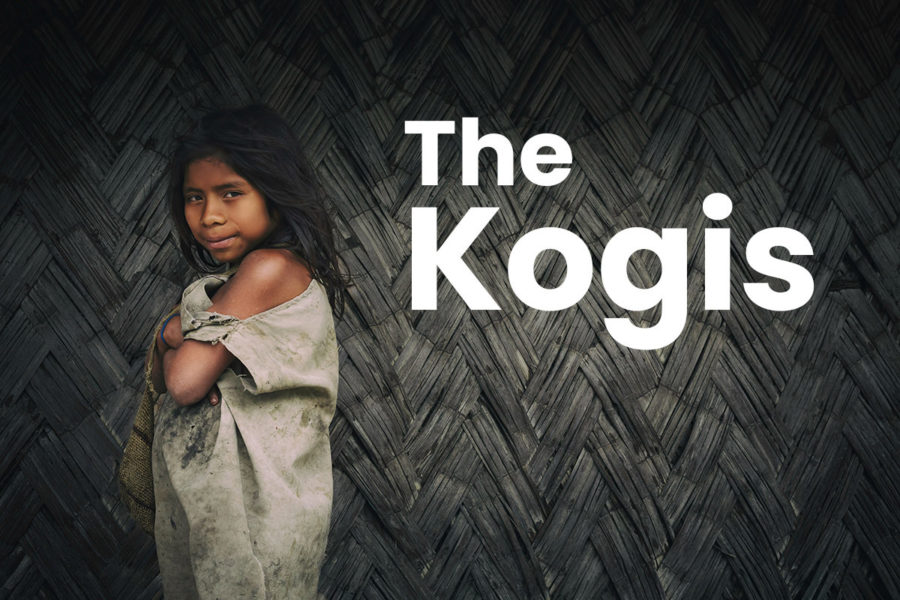

Heirs of an ancestral culture, the Kogi Indians are the last descendants of one of the greatest civilizations in Latin America. Photographer living near the Sierra Nevada de Santa Marta for 4 years, I have had the privilege of sharing extraordinary moments with this unique culture. I share with you here all that I have been able to learn alongside the Kogis in recent years: culture, tradition, beliefs, etc…
Who are the Kogis ?
The Kogi community is a native people who live in the Sierra Nevada of Santa Marta , Colombia. They call themselves “Elder Brothers” and think they have a superior mystical knowledge and perception than others. They refer to other communities as “little brothers” (hermanos menores).
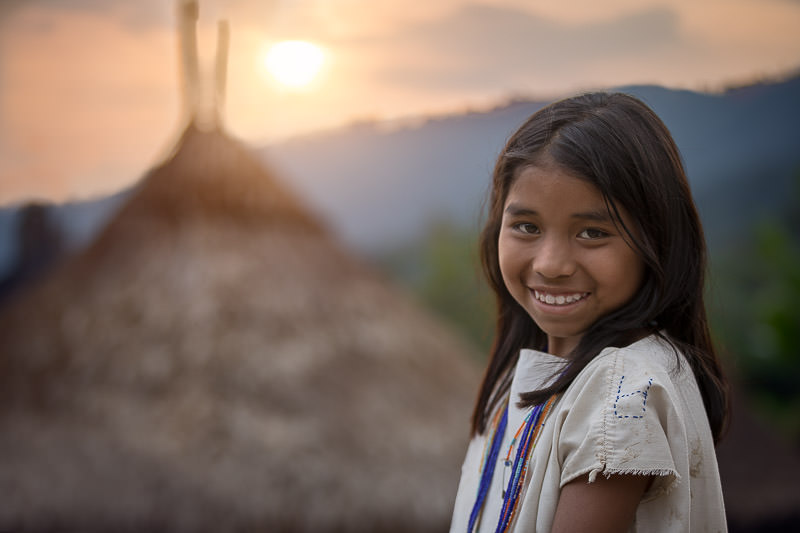
Where does the word Kogi come from?
Kogis are also known as Kogis, kouguian, kogi, cogui, cogui, and kággabba. The word Kággabba would mean, according to anthropologists, “Real People”. Other say “Son of the Jaguar”.
History of the Kogis
Pre-Columbian era
In the foothills of the Sierra Nevada, there was a culture represented by several apparently exogamous groups or tribes, namely the Kogis, Tayrona (or Tairo) and Matúna. According to Reichel-Dolmatoff, following the Spanish conquest, coastal groups were partially acculturated, but others, such as Guanebucán, and Matúna (kurcha-túxe) also fled to the mountains of the Sierra. The current Kogi tribe is made up of the former Kogi nucleus and members of the Guanebucán, Tairo, Matuna and even Sanka (or Wiwa), integrated into the former social organization.
The Taironas
The Taironas were organized in the form of Caciques kingdoms. These groups were located around 3 main cities which were Pocigüeica, Bonda and Taironaka. Each of these cities had a main cacique who led the minor caciques of the surrounding villages.
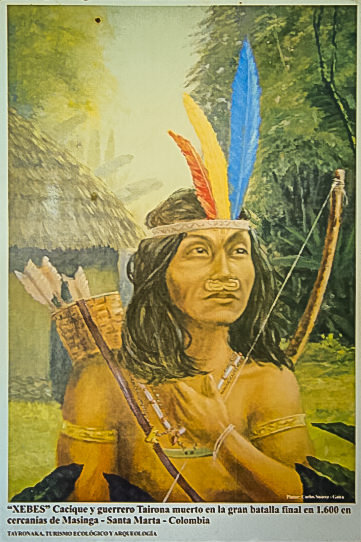
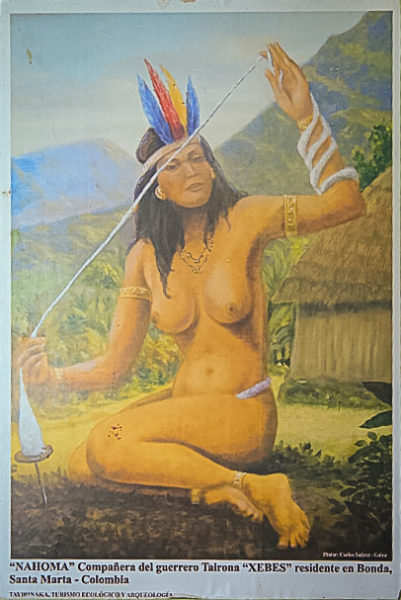
The social organization was already very developed, and each community played a different role in society. Many roads and stone paths dedicated to trade had been weaving the Sierra Nevada for several centuries.
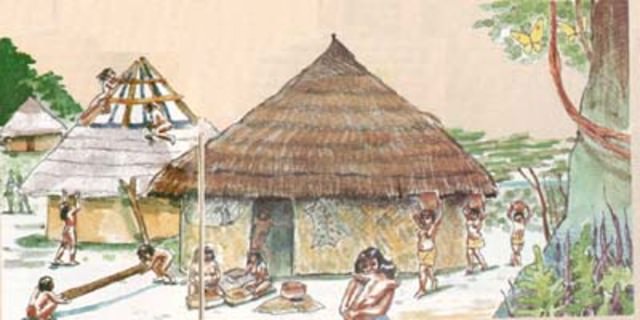
The fact that they already had a large communication network gave them the title of “Civilization” according to Spanish criteria, in the same way as the Muiscas, Incas and Mayas.
Origin of the word Tayrona
The word Tairona would come from Tairo which means “Goldsmith” or “foundry” in the indigenous language. Indeed, at the Santa Marta Gold Museum, there are magnificent statuettes of great finesse made by the taironas. These are some of the most beautiful pieces in Colombia.
The arrival of the Spaniards
Rising to 5775m above sea level, it is the snow-covered peaks of the Sierra Nevada that would have attracted Rodrigo de Bastidas’ crew in 1501 to the Caribbean Colombian coast.
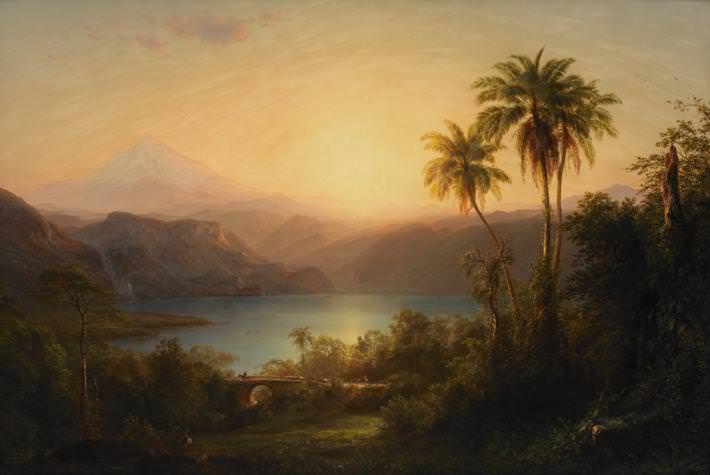
When they arrived, the indigenous people lived in much the same way as they do today.
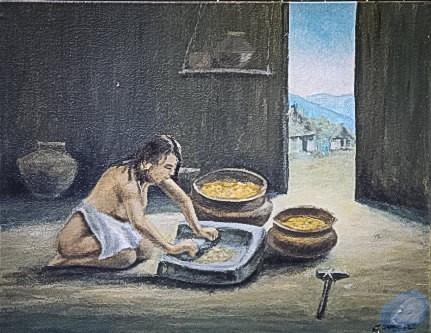
First settled in the calm waters of Gaira, Rodrigo de Bastidas founded one of the first cities in Latin America 24 years later: Santa Marta. He had one objective: to build the city of his dreams and to make a civilized conquest without massacres or persecutions.
Rodrigo de Bastidas who, despite what is said, had fallen in love with culture and maintained friendly relations with the local population.
Relationships were rather friendly in the early years.
They were asking for gold and blood, that’s why they came for. With a sword in hand they quickly went hunting for the natives and murdered Rodrigo de Bastidas shortly afterwards. (See article “un Gran related de Amor“).
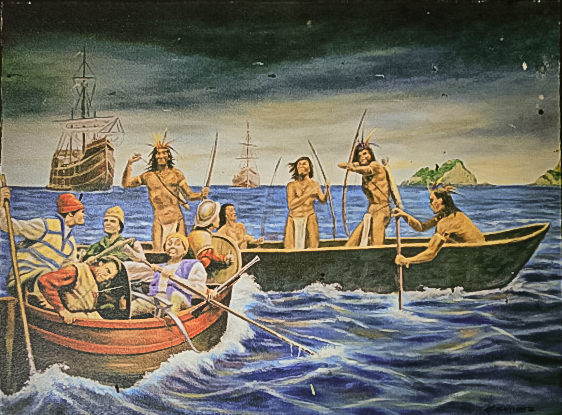
The Night :
From then on, what the Kogis nicknamed “La Noche” began, the dark side seized Colombia. Facing the men in metal armour with their horses and trained dogs, and against the harquebuses that spat fire, the natives could not fight. The “Aboriginals” then ceased their armed resistance and bowed to the new masters who spoke a strange language and worshipped another distant but no less relentless God. The great city “Teyuna” was quickly looted, burned, and women raped. Despite their resistance – Santa Marta was burned 20 times in 150 years – in a few generations, their culture was totally destroyed.

However, a handful of them found refuge in the inaccessible valleys of the Sierra Nevada, towards the foggy peaks. This sacred domain was then almost uninhabited. Before the Spanish arrived, the Taironas had already been forced to take refuge in the heights of the Sierra Nevada around the year 1000, invaded by the Carib Indians. Over time, this withdrawal proved to be life-saving and allowed the Kogis to live cut off from the world until the 1950s.
Origin of the Kogis
Here is a very nice video that represents the myth of the origin of the Kogis: Cashinducua and the creation of the Kogis
Where do the Kogi live?
The Kogis live on an isolated pyramid-shaped mountain range called the Sierra Nevada de Santa Marta.
It is the highest coastal mountain in the world: barely 40km separates the sea from its snow-covered peaks, which rise to 5775m.
If we take Everest from the base of its plateau, the Sierra Nevada is higher.
Many geologists describe it as “a miniature copy of the entire planet”.
The Sierra Nevada would have surfaced more than 300 million years ago, while the much younger Andes Mountain Range would have been barely 15 million years old. The Sierra was therefore an island before the Colombian plateau surfaced. It thus possesses an incredible variety of endemic species, and is home to 7% of the world’s biodiversity. On its 4 thermal floors, there are beaches, rain forests, jungle, fog forest, then Paramos from 4000m.

indigenous territories
In the Kággabba vision, the territory is delimited by the sacred sites that surround the Sierra Nevada and form an invisible “black line” that separates them from the civilian territory. In these places, offerings, consultations and collections of materials for ritual use are carried out. Of the 1,700,000 hectares of Sierra Nevada, only 364,390 hectares constitute the indigenous territory. The largest Kogi villages in the Sierra are called: Marwámake, Surumuke, Chendúcva, Surachuí, Avingue, Seyuyaku, Kasakumake, Gumake, Umandita, Kuisis, Nimaysi, Taminaca, Mamarongo and Jiwatá.

Officially, Colombian law does not have any effect within this area. These are “resguardos Indigenas”, and there the indigenous law prevails. Thus, if someone commits an offence in their territory, they will not be subject to Colombian laws and they can decide to lock him up for several months if they so wish.
Limited access to Indigenous territories
No civilian has the right to cross this black line without permission. You need special permission to go there, without which it is impossible to get in. That’s what protects the Kogis. Only the Lost City and a few villages near Palomino are accessible to civilians and in a controlled manner.
Population
Official DIAN figures in 2005 showed that only about 9,000 indigenous Kogis still live in the mountains. But the figures are inaccurate and contradict each other. Other censuses go up to 25,000. When the Spaniards arrived, there were almost a million of them. The Kogis currently represent 0.66% of Colombia’s indigenous population.
The four communities of the Sierra Nevada
the Kogis also have other older brothers who live on other slopes of the Sierra Nevada: the Arhuacos, the Wiwas and the Kankuamos.
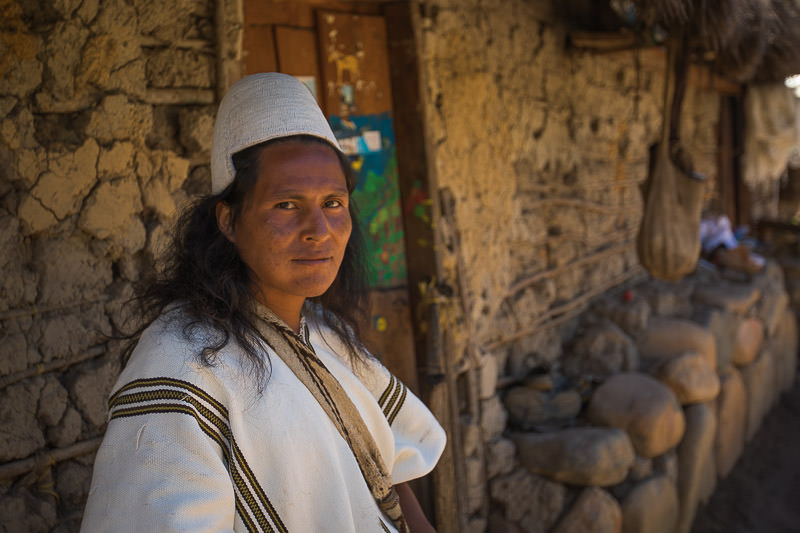
Language
Kággaba belongs to the Chibcha language family found further south on the Andean plateaus, but it is believed to have been mixed with the Arhuaca language. Of the 4 communities we find today, each speaks a different language.

Although the languages of the Sierra belong to the same linguistic family, the natives have difficulty understanding each other. A Kogi understands hardly an Ika to speak, however they manage to assimilate the Damana (Wiwa language). The Kankuama language was extinguished a few decades ago.
The Kággabas only learn Spanish in school, and many speak it only very little. In fact, the higher you go up in Sierra, the less they speak it. 84% of Kogis still speak the native language, which shows a high level of cultural conservation The Mamos speak the 3 languages of Sierra Nevada. Mamus can also recite in the ancestral language, Teijua (ancient Tairona language), which no common Kogi can understand. In the small territory of the Sierra Nevada there are already differences in accents and words between some valleys.
Kogi Dictionary
| English | Kággaba |
|---|---|
| Hello | Moun zekh |
| Good night | Kun ze khue / Toun zekh |
| Welcome | Enchibe nakh |
| A woman | Ezua munzhi |
| A man | Ezua Sigi |
| A child | Soma |
| How are you doing? | Saki minoje |
| My name is | Nes nakh juka |
| What’s your name? | Semi khajuka |
| Good / great ! | Entchive |
Kogi Beliefs
The Origin of Life
At the beginning there was nothing. Sé. There was only darkness. There was only the mother alum, a pure thought without form. She started thinking, and she designed the world in the dark. She conceived us as ideas. She conceived us as ideas. As if we were thinking of a house before building it. She turned the thread. Making us turn in history. Creating us in thought. Then came the light. And the world was real.
Excerpt from “Aluna the film”
Jate Sezhankwa: The first being
This thought was at the origin of all being. And from there came all the first spiritual beings, creators of the Kogi world: Sukui, Seyankua, Kajantana, Seinekun, Duguenavi and Seraira.
Cosmo-vision
The Kogi belief is very close to that of the cosmic structure of the universe. They think that everything is duality. From a cosmic point of view the sun separates the universe into 2 hemispheres, there are man and woman, hot and cold, light and darkness, etc… Each group has its opposite pair. In each pair, one cannot survive without the other. These natural opposites are a way of keeping balance in society, or in “harmony” (Yuluka)
The Nine Worlds
The universe for the Kogis is conceived in a symmetrical way like a coil of yarn, whose central disc limits the 2 Cosmic parts. The upper portion is the one that corresponds to the illuminated, visible and beneficial parts. Its opposite, lower world represents the dark counterpart, in scale of value up to the lower world.  In this one would exist 9 worlds, each with its own land and inhabitants. The earth is located in the middle, on the 5thfloor.
In this one would exist 9 worlds, each with its own land and inhabitants. The earth is located in the middle, on the 5thfloor.
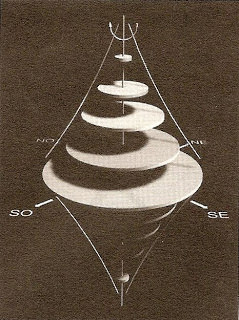
What Does Sierra Nevada Mean For The Kogis ?
The Sierra Nevada is considered a human body, where snow-covered peaks represent the head, lagoons and high plains (paramos) form the heart, rivers represent veins, layers of soil represent muscles and tall grasses represent hair. From this base, the whole Sierra is a sacred space.
On the whole planet and in all cultures there are sacred places. These places connect human beings with all living beings on the planet, right down to the cosmos. This is where the planet’s vital energy flows most forcefully. Indeed, for the Kággabba people, the Sierra is Sé Nenulang – the physical and spiritual universe with all its components. In them are the codes of the rest of the planet. The indigenous people of the Sierra believe that Sierra Nevada de Santa Marta is connected to the whole planet through its sacred places.
Their Relationship With Mother Earth
The fact that the Kogi Indians have highly ritualized behaviors is intrinsically linked to their territory. As a result, a Kogi will not plant seeds, cut down a tree, divert a stream of water for irrigation, build a house, harvest fruit, or hunt an animal without consulting the Mamo, who will not only indicate the spirit in which authorization should be sought, but also the precise place in which the payment rite should be made, in order to obtain authorization. We must return what we take from mother earth For the Kogis, cutting down a tree is “picking a member of the mother”, hunting an animal, “taking a son from the owner of the animals”. Actions for which it is necessary to “give back in the spiritual” what is taken from the mother and the spirits

The water
Water means everything to the Kogi, a true living being, the blood that circulates in the veins. Imprisoning water in dams seems inconceivable, it’s like making a withers. The relationship of the Kogi with the sea is totally different: they compare it to the amniotic fluid of the mother earth and consider that it is not made for swimming. When they walk to the sea, they turn around on themselves as a greeting.
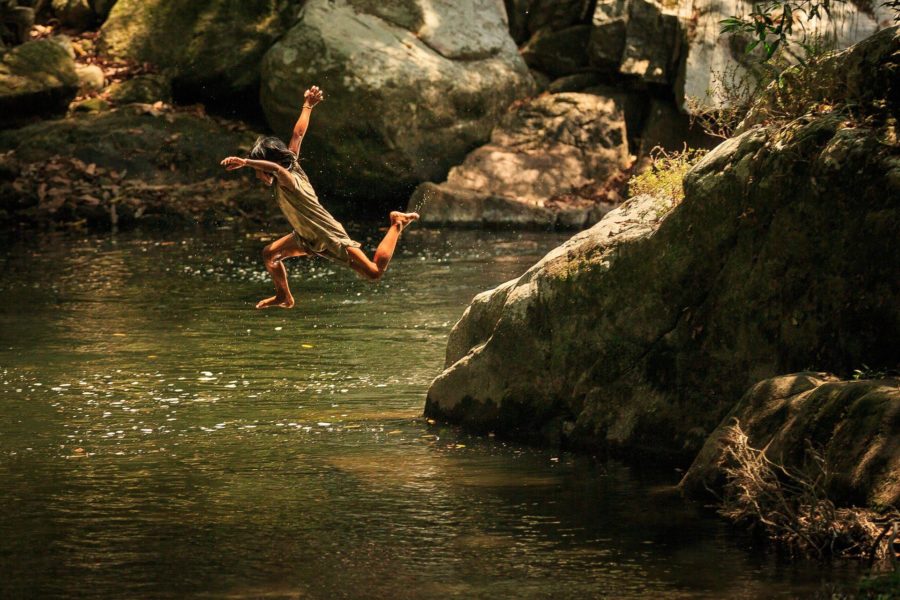
The balance
The balance For the Kogis, everything is balance and harmony. If we upset this balance on the planet, ecological disasters follow, such as earthquakes, droughts, floods, hurricanes, etc… They fear, and they are not wrong, that we little brothers will destroy everything on the planet. Our elder brothers believe that it is their responsibility to watch over the balance of the planet. When ecological disasters strike the world, spiritual authorities carry out large “Pagamento” (offerings) marches, with the aim of restoring balance and returning to the planet what was taken from it.
The Offerings
Although many offering sites are now known to the civil world (such as the site of Piscina in Tayrona Park), a large part remains known only to the Mamos. Specific points exist for each type of event. The type of offering can range from natural cotton to shells, or quartz, a stone very rich in energy according to the Kogi culture.

Kogis’ Social Organization
According to Cosmo-vision and Kággabba mythology, the social schema of the village is based on the original law, which is the norm of man’s behavior towards nature. Originally among the Kogi Indians, there is no socio-political organization involving a centralized authority, nor a supra-community organization on a given territory. This is very different from the feeling that they all belong to the same ethnic group that shares the same language, customs and ancient religion. Instead, there is a mosaic of farming communities, organized around villages and ceremonial centers, each led by the dominant figure of an indigenous priest. Each people, with its Mamo and its respective inhabitants, create an autonomous unity.
Hierarchy Within the Village
The Mamo, a spiritual leader with a supernatural consciousness, is the representative figure in the social life of the village. He is assisted by a secretary ( Takina, who generally is Mamo himself). After Mamo are the major and minor commissioners (Makotama) who are responsible for enforcing the laws and managing the village’s expenses. Then come the major and minor cabos (Seishua) who also ensure that the village remains attentive to the demands of the superiors. The rest of the village are the “Guás”, and carry out daily life work to support the village.

The Mamo
The Mamo or Mama, represents the central figure of Kogi culture and embodies the sacred law. He is the key between the celestial powers and men.

Brought to a high level of consciousness, their role is to maintain the balance of power in the village but also throughout the world, through songs, meditations and ritual offerings. For the village, he acts as an advisor, teacher, doctor and priest. A good Mamo listens to the Guas in confession to determine what offense to the Mother was the cause of the poor harvests. The Mamo, in short, is the only one who can decide when the many religious holidays should take place, because he is an accomplished astronomer. In its isolation and distance, the Mamo is feared and respected. He has the authority and supernatural power to affirm it, and the Guás obey him when he speaks because he is a good Mamo, their protector. When the Mamo arrives, everyone gets up and greets him with the word “Haté”.
How are the Mamos chosen?
Mamos are selected from the earliest age. The Mamo in place will generally choose the wisest of children, and the most “concentrated”. From the age of 5, the child is taken to the sacred sites of the Upper Sierra Nevada, where he learns to meditate on the natural and spiritual world. The mother of the elected representative has the right to visit him in the evening and sing songs to him. The child then begins to dance. So she has to go back and leave him. This is a training course of a minimum duration of 18 years. According to legend, it is said that the apprentice is locked in a cave for the duration of his apprenticeship. Thus, a Moro (Mamo apprentice) knows nothing about nothing. He never sees trees or birds, he knows nothing about the world outside his cave. He will not be allowed to see light for all his years and will devote his time to raising his consciousness to a higher level. To make it strong, they rub it, massage it with a kind of fabric made of Watta. He must follow a very special diet. It is also given a kind of potato and white corn, all accompanied by a white larvae. He drinks only purified water from the stone mortars of the house, holy water. Then the child learns by listening, by listening spiritually, the knowledge comes to him from Aluna.

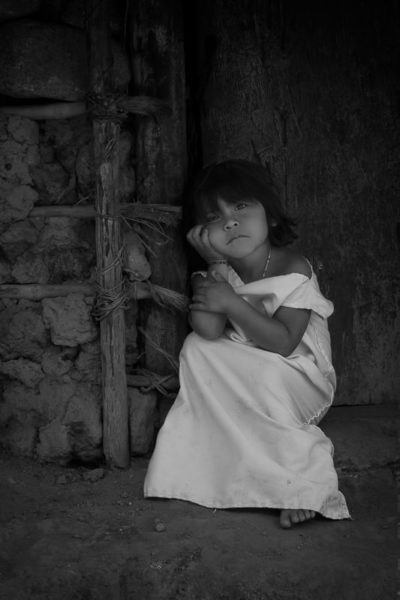
The Kogis Village
The Kággabbas live in small villages called Kuibulos. On average, villages have between 20 and 40 huts. Each family owns 2 or more plots of land in the area, with agriculture being the main activity of the economy. They only come back to the village for the days of meetings at Mamu’s request.
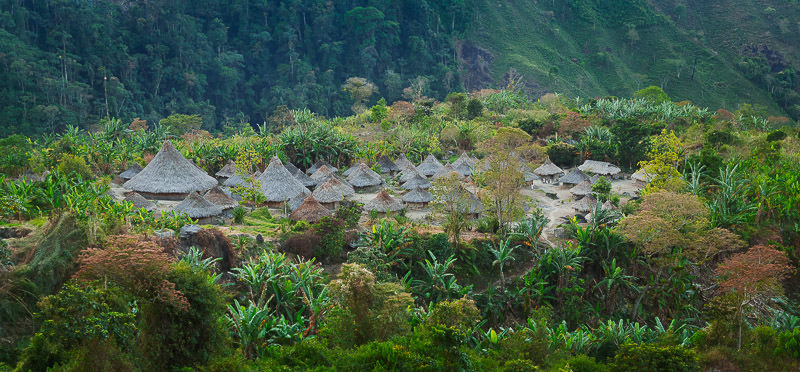
The Seminar Hut: Nunkhue
Each Kuibulo also has 2 “Nunkhue” or “Cansamarías”, which are the main huts dedicated to meetings. Its architecture is different from that of other cabins. Much larger than the others, it has two opposite entrances. Only men can enter Nunkhue – it is here that village affairs are discussed and tradition is passed on. Women also have their own Nunkhue. During the ceremonies, men and women are then separated and discussions vary. Women are often responsible for passing on the tradition to their children. Nunkhue’s architecture is highly symbolic and in fact represents the nine worlds that make up the cosmos.

We can distinguish that its walls are different from other houses, because they are made of reed fibers, while the houses are made of “kelp”, a mixture of straw and water earth, in order to better retain heat.
Tradition has it that men enter through one entrance and leave through the other. When official meetings are scheduled, the Kogis bring a branch of wood with them as an offering, and will be used to fuel the fire on long nights of meetings. This tradition is still valid, even at school the children bring a small branch to feed the fire for lunch.
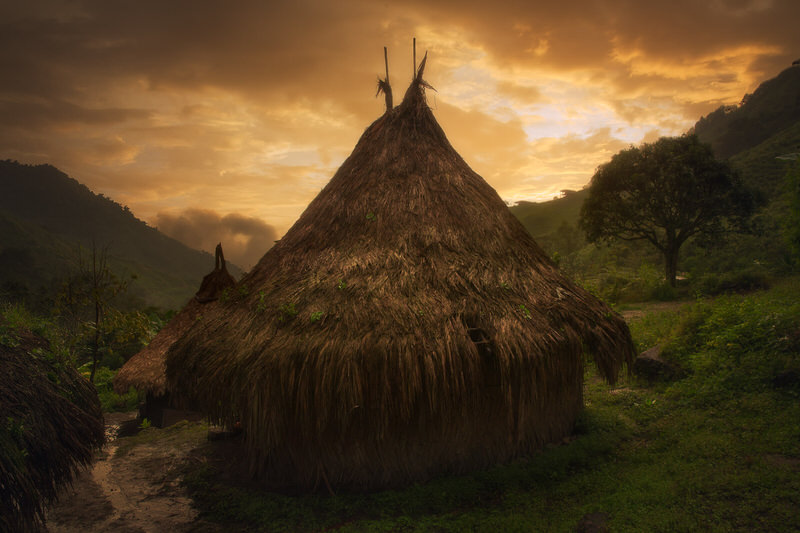
The House
When you take a closer look at their way of life, they generate almost no pollution. Their houses are made with only the natural materials that surround them: mainly cob, wood and palma seca (a variety of palm tree). Inside, we find only the bare minimum. The central fireplace, and possibly a small shelf, a small hammock and nothing more. The Kogis sleep on the ground, without any mattresses or blankets, warming themselves to the heat of the fire. And yet, I can tell you that it can be cool in the heights of the Sierra Nevada. Real warriors ! A guide once told me that this house is a kind of metaphor for the land. Its circular shape would evoke the planet, whose focus would be its gestative magma, and the walls are bark. Men gather and help each other to build houses. A ceremony is often conducted by the Mamo during the inauguration of this one.
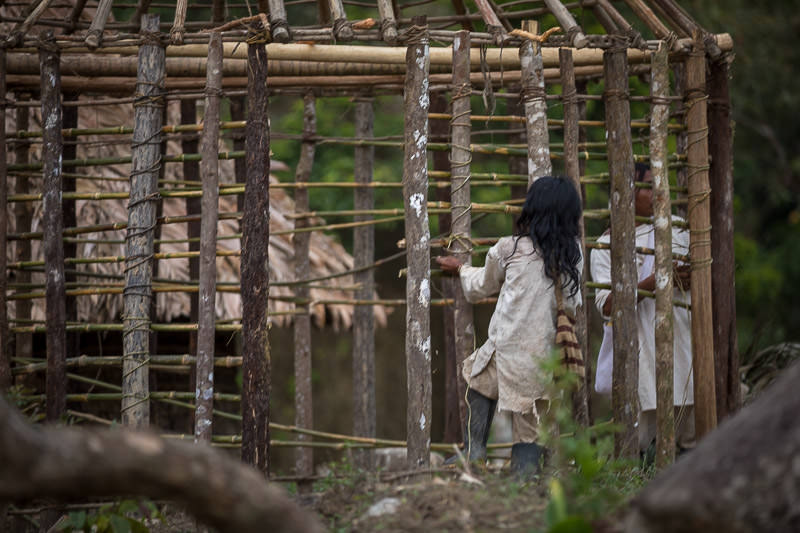
The 2 extremities seen on the roof are also a metaphor for the 2 sacred peaks of the Sierra Nevada de Santa Marta. It would also connect with the energies of the cosmos.

The family
Social organization is also supported by the family unit, conformed by the husband, wife, unmarried children and girls married with their respective husbands. They are organized into patri-linear and matri-linear lines, the former being called “Tuxedo” and the latter “Dake”. Children belong to the paternal line and girls to the maternal line. Each segment of the lineage is linked to a village and a ceremonial house. In general, the son receives the inheritance from the father and the daughter from his mother. Thus, men are the owners of land and livestock, and women are the owners of houses.
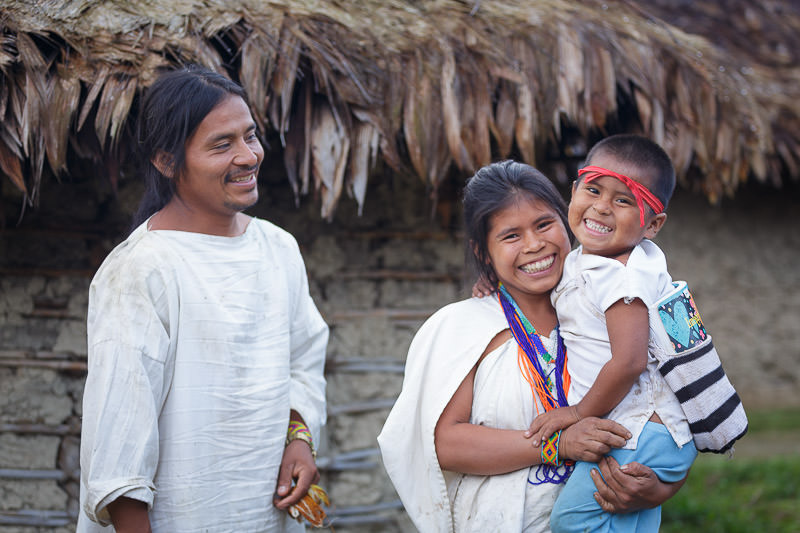
Economy of the Kogis
The Kogis live practically self-sufficient in the Sierra, and therefore have minimal financial income. The village’s money is managed by the Commissioner and is used mainly for travel, when they have to meet between communities, or for collective work such as trail maintenance and bridge construction.
Community work
In the most traditional villages, fruit and vegetable harvests are done together with the family or between men. The crops will be redistributed equitably according to the work each person has done. One of the only financial contributions I have seen is through the work of women and the design of fiqué mochilas. One of the only financial contributions I have seen is through the work of women and the design of fiqué mochilas. A mochila woven by an ancestral know-how, made of entirely natural fibre, should be worth a fortune!
The Zhigoneshi Concept
Zhigoneshi: This is the exchange of work without pay. Brothers-in-law and brothers are preferred, but it can be with neighbours. It is measured in working days, which must be paid at the time of the counterparty’s request. Failure to comply with the obligation to provide services may be brought to the attention of the Commissioner, who will raise the case in Nunhué, under the scrutiny of the rest of the men in the community. Under no circumstances is this non-compliance reported to Mamo.
Feeding
Kogis’ feeding is based mainly on subsistence agriculture.
In the past they had access to the four thermal floors of the Sierra Nevada but the reduction of their territory by settler farms limited them to one plot per family.
The arrival of settlers in the 15th century disrupted their diet. They have experienced a great loss of food quality with the introduction of new starch-rich plants. This would have greatly affected their metabolism. Fishing Before the arrival of the Spaniards, it seems that the Taironas were fishing a little. Some say that the pool site in Tayrona Park was created by the natives to create a pool and fish more easily. Agriculture The loss of access to the sea has also cut off trade and barter flows between the different levels of the Sierra, which allowed them to have a more varied diet. Indeed, on the coast, everything has to be paid for… However, the Kogi Indians know how to skillfully use the differences in altitude to obtain harvests at different times of the year. On the drawing below, we can well imagine their diet:
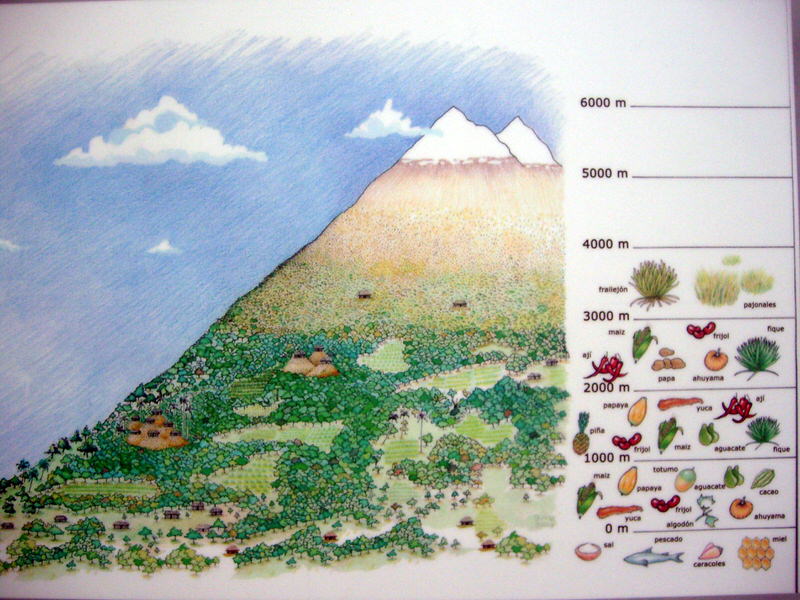
Ancestrally, they cultivated potatoes, cassava, malanga, sweet potatoes, corn, beans, beans, etc… Not to mention the Coca leaf, an energy and spiritual food. Since their return near the colony lands, they have started to grow ripe crops and Lulo, which are endemic to Colombia. Coffee, plantain bananas, sweet bananas, mangoes, pineapples, sugar cane are now part of their agriculture, but they are plants introduced by the settlers. They also breed domestic animals to supplement their diet, and no longer hunt as before.

contradictory agricultural techniques Although the Kogis live in perfect harmony with nature, they practice a somewhat contradictory method of cultivation: burning. Often, during my walks, I have often seen them set fire to mountainsides without any control over its extent. It is indeed much faster than pruning by hand, and it brings in good harvests in the first few years. However, this technique has serious ecological consequences on the microorganisms and bacteria necessary for the mountain.
Health of the Kogis
The medical system is an important aspect of daily use. In the Kággaba health system, it is the Mamu who master the science of plants. They practice sacred orations as they apply various mixtures of plants, resins, minerals, stones and other natural elements of their environment.
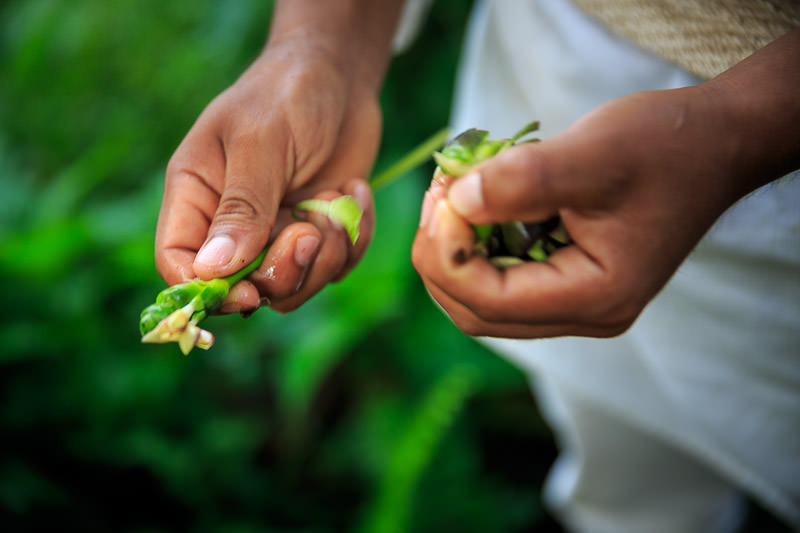
In the lower floors of the Sierra, the Colombian government has provided infirmaries. Unfortunately, this is disrupting the Kogi health system and plant knowledge is in decline. For the most traditional villages, diseases caught in the Sierra will only be treated by plants. However, for the types of diseases originating from the civil world, they allow themselves to use Western medicine in cases of extreme urgency. Children often suffer from bronchitis because there is no smoke evacuation in the huts. In the rainy season when the wood is wet the house quickly turns into a bath of dense smoke. Despite having a very healthy lifestyle, it is one of the things that affects young children the most. We remember a case of a serious epidemic in the village of Taminaka that unfortunately killed 11 people before the Kogis could ask the government for help. Located 3 days walk from the first city, they no longer had the strength to walk and had to be evacuated by helicopter.
Education of the Kogis
According to a 2005 DANE census, the percentage of the Kággabba population that can neither read nor write is 81.66%.
This is relative because a higher proportion of the population believes they have some level of education.
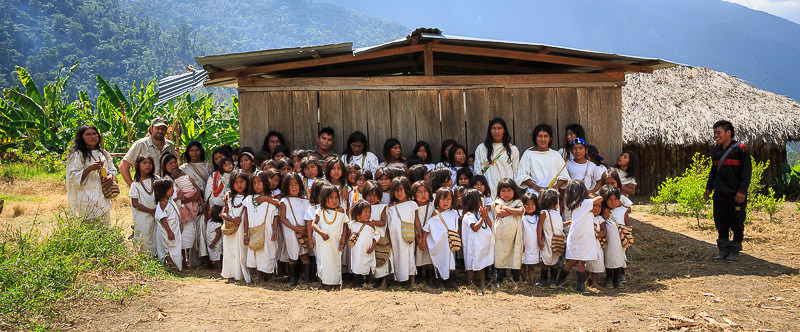
In recent years, the villages have now been equipped with a school. This one is not of typical architecture, but they allow it because this system comes from below.
In the highlands, the teachers are generally native natives and teach in Kággabba and Spanish, but in the lower parts of the Sierra, the teachers are mixed civil / Kogis.
Having seen it in action, however, the level of study remains superficial and of short duration.
Classes last about 6 hours a day, and most children study until the age of 13-14 before moving on to agricultural work.
Some children sometimes live 4 hours walk from school and stay at the boarding school before going back to the farm on the weekends.
Parents and children love school for one thing: free and varied meals.
This changes them from the daily malanga and yuca of the house.
Is school beneficial for Kogi children?
Questions may be asked about the right to education imposed on these communities, whose knowledge has been transmitted orally for centuries.
Learning the history and sciences of the civil world undoubtedly influences the behaviour of this new generation that is today in a certain dilemma: that of remaining in the tradition of their village, and the temptation to go and see what is happening elsewhere.

Kogis Customs & Traditions
The Past And Traditions
The Kogis are one of the peoples who have best preserved their traditions over time. Respect for traditions is at the heart of culture. At meetings, where oral traditions are the basis of teaching. They tell each other anecdotes, some of which go back centuries ! One factor to be taken into account is that to protect themselves from the atrocities of the Spanish conquistadors, the Kogis took refuge in the impenetrable heights of the Sierra Nevada. They have thus lived a few more centuries without having any contact with civilization. This isolation has allowed them to be less influenced by the civil world than other cultures. Once, when I slept in a native village in the Sierra, I was impressed by the comfort of our hut: there was almost nothing in terms of comfort, except the fire in the center and a few logs of wood to sit on. I then ask my host: “But since you have already seen chairs, tables, beds, why don’t you build some for your houses? ». Her answer was simple. She replied, “It’s against tradition.
The best way to communicate with our ancestors and make our ancestral traditions a reality
Kogi Thought
The Kogi wedding
The Kogis are mainly Exogamous, and must find their wives outside the group. Before getting married, a man must present his sweetheart to Mamo. He is the one who will authorize or not this union. To celebrate their union, the Mamo will give it 2 quartz to which it will transmit good energies by orations and spiritual songs. There are many Kogi and Wiwa couples. Generally the woman is Kogi and speaks both languages: Kággabba and Damana. The children of these couples speak Kogi, but in some cases the father teaches Damana to his children.

The funeral
For the Taironas the passage to death was also considered as a great journey, during which it would pass several tolls. That is why they gave him his favorite objects and some of his treasures for this trip. According to the Austrian anthropologist Gerardo Reichel-Dolmatoff, the Kogi burial is still close to the rite practiced by the Taironas. A metaphor for the gestation period, but in the opposite direction. A return to Mother Earth’s womb. The Mamo participates in various rituals to celebrate the cycles of life from birth to death. Although each cycle of life is celebrated, the funeral ceremony is very important for Kogi culture. In this community, death is not seen as a tragic event but as an achievement of life. The funeral lasts about 2 hours and is celebrated without prayers or songs, which may seem simple. In reality, it is a rite of “cosmification”. Indeed, when a person dies, the Mamos send them back to the uterus of the Pasha Mama.

The deceased is thus returned to the womb of the mother earth in the position of a foetus. The funeral takes place in several stages. As the soul of the deceased was still present for several months, the body was buried in the centre of the house in a funeral urn until it left its carnal envelope. It is only 9 months later, after the deceased knows his second funeral and the remains are returned to nature.
The Coca Leaf
The Coca leaf called “Ayu” by the Kogis is a sacred plant. It plays a central role in daily life, and is a way of socializing. Since the Taironas, Coca is a food, because of its high vitamin and mineral content, but it is also a spiritual food.

Its energizing virtues also allow them to keep their strength during long walks in the Sierra Nevada, while cutting off their hunger. During the long ceremonies, it will allow them to stay awake for up to 3 nights in a row. In the tradition only men have the right to chew Coke. However, it is the woman who collects the leaves. In the process man will be more concerned with preparing the land. Preparation Of The Coke Leaf Once the harvest is over, the men dry the Coca leaf in an accelerated manner. For this reason he puts a round stone on the fire for a few minutes until it gets hot. Then he places it in a mochila in which the leaves are located and shakes the bag so as not to burn the leaves.

Each man carries a small mochila with coca leaves on him, which he chews to obtain a slightly stimulating effect. When two men meet, a handful of leaves are exchanged as a sign of mutual respect.
The Poporo
Poporo is the identity card for every man. It is composed of 2 accessories: a kind of hollowed-out calabash that contains crushed shells and represents femininity. The second accessory is a wooden rod, which represents masculinity. It is used to bring the shell powder to the mouth, while they chew the Coke. The strong alkalinity of the shells reacts to contact with coca and releases its active ingredients.
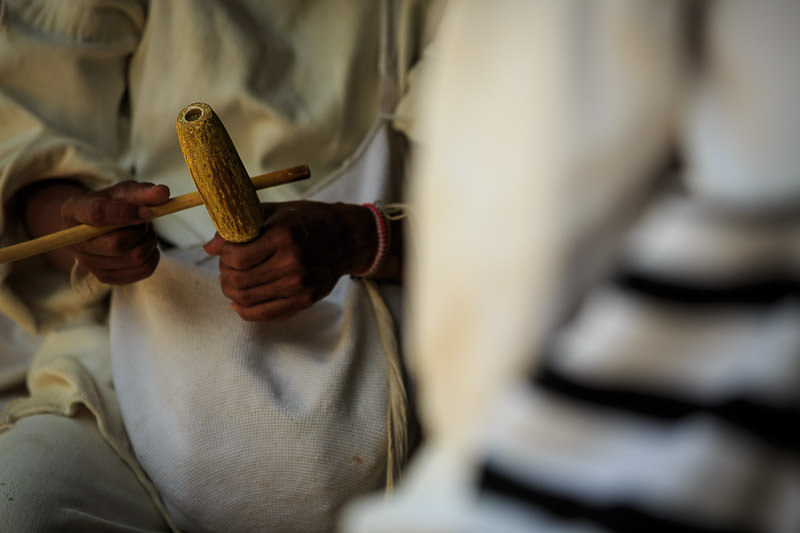
These shells are found in specific areas of the Caribbean coast, and are not harvested in any way. The sea deposits them at night, and they have to pick them up before it takes them up again in the morning. It is during family pilgrimages or seaside ceremonies that the Kogis will collect them. The shells are boiled for long hours until they turn all white. Then they are crushed to obtain the powder of the poporo After chewing, the remaining shell dust, mixed with saliva, is deposited on the neck of the poporo and eventually becomes a thick neck over time. The shape of each popora being entirely unique, it represents in a way the identity card of each man. Over time, the poporo orifice is covered with a thin layer of calcium hardened by the repeated friction of the stick.
The Spiritual Value Of Poporo
We often see the natives rubbing their sticks on the Poporo, mechanically, even though the stick is already dry… In reality, this is a highly symbolic gesture: they record or “write” their thoughts on their Poporo. So when we see the size of some mouthpieces, we can estimate the level of wisdom of the person, and imagine the level of consciousness he has acquired. Out of respect for the elders, young people should ensure that the orifice of their Poporo is no wider than that of their elders.
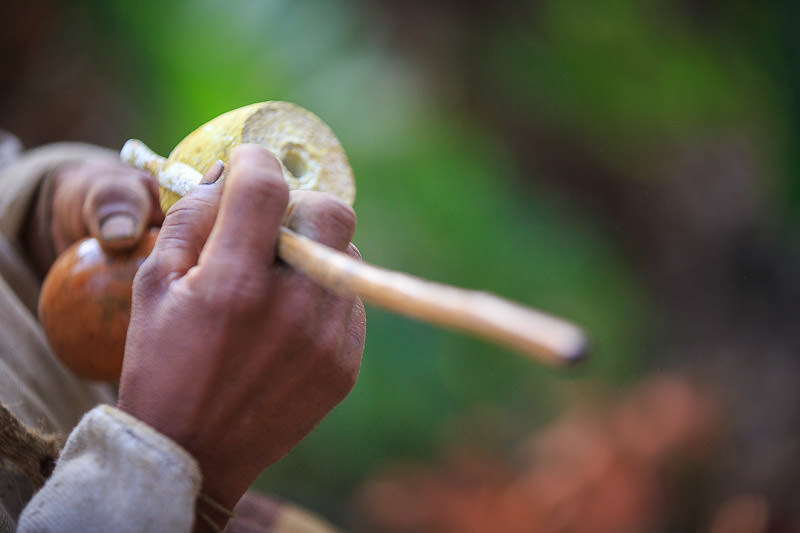
For a boy, the gift of the first poporo marks his rite of passage to adulthood. It is the Mamo who will decide when the child is ready for Poporo, according to his level of maturity. He will then have to spend 3 nights without sleeping and listen to the stories of the spiritual leader who teaches him life and how to become a man.
Coca and Kogi Consciousness
It is like Wifi for the Kogis and allows them to stay focused and connected with the Pasha Mama. They are thus permanently in a state of advanced consciousness. Sometimes they chew for several days without sleeping, it is this state of high concentration that would help them to take a sufficient distance from the world, to know what is really necessary in life forever and what is vital for the planet.
The Dilemma Of The Coca During The Guerilla
But coca is also cultivated by non-indigenous settlers as a raw material for cocaine. Colombia has long been the world capital of this drug and its production has had devastating consequences for the indigenous population. Despite the peaceful nature of the Indians, they were often caught in the crossfire between the army and illegal armed groups. As a result, many have died murdered, others have been forced to cultivate it and remain forced to flee because of this type of civil war that is ravaging their lands. Settlers cultivate coca for drug trafficking, mainly financed by the armed conflict between guerrilla and paramilitary groups, occupying the lower peaks of the Sierra during the country’s long civil war.
What Does the Walk Mean
For The Kogis The action of walking in the Sierra is also a metaphor for the act of weaving. Maintaining the paths of the Sierra by walking would be considered as the act of weaving a mochila.
Art & Culture
The Mochilas
Weaving activity is a widespread and valued role within the Kággabba people and is purely part of the kággabba tradition. Women are the ones who practice weaving. The Mochila is a bag used for transporting personal belongings. Women make their first Mochila from an early age. The little girls bring their first Mochila to the Mamo that will bless it. So quickly the gesture becomes innate, to such an extent that they practice this activity while hiking in the Sierra Nevada.

Les fibres qu’elles utilisent sont 100% naturelles, telles que le fiqué et le coton. Celle en fiqué est d’usage courant, tandis que celle en coton, sera porté en signe d’élégance ou par les personnes importantes. Les teintures utilisées sont des racines, feuilles et écorces d’arbres. Il faut entre 1 et 2 mois pour réaliser une mochila. Quand on se rend compte qu’elles sont vendues 40.000 Peso (13 euros) pour autant de travail cela fait mal au coeur… Chaque ethnie de la Sierra à ses propres motifs et techniques de tissage, et chaque motifs ont leur propres signification. Les Arhuacos ont une technique totalement différente et utilisent beaucoup la laine.

Use of the Mochila There are 2 types of Mochilas, one dedicated to the transport of food in general in large fibres, and the other for provisions. The use of mochila is not the same between men and women. Indeed, we will never see women wearing the mochila around the neck except in a band around the head, especially to carry babies. Men wear 2 or even 3 mochilas. One of them is used to carry the Poporo, and it also has a smaller mochila inside the first one that will be used to store its coca leaves. I have also heard that when men wear the mochila in a cross, it is a sign of spiritual retreat. This Mochila is also very practical to distinguish children. When they are little, they already have all the long hair and the same toga. The mochila thus makes it possible to recognize the boys of the girls because the boys wear the mochila and the girls wear necklaces

The music
Music is a way of transmitting stories and visions. It’s called Chicote, like the Wiwa’s. Kogi music is characterized by a monotonous and repetitive sound, a song to nature. Only the Mamos can play an instrument called kuiguma, made with a morrocoyo shell. I even saw once an unusual instrument among the Kogis: the turtle. They rub their hands on the opening of the empty shell, and this produces a vibration whose sound is close to Tibetan bowls. For the other instruments, they use elements such as sea shells, and pieces of wood, and instruments such as Gaitas (flutes made of reeds).
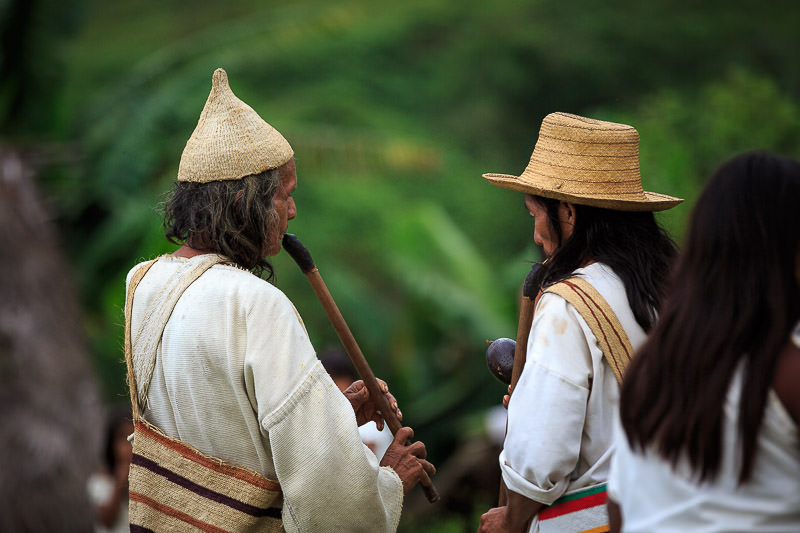
Through music, they simulate the sounds produced by the sea, rivers and animals. Traditionally, men play Gaita, maracas and drums, while women dance with kumuna and kuckui, a kind of rattles attached to the ankles.
The dance
There are 2 words in Spanish for the word dance: Bailar and Zapatear. The word zapatear comes from the word zapatos (shoes), and has its full meaning with indigenous cultures. Indeed, the act of dancing is often a connection between the earth and the cosmos. The patterns of the steps are tributes to the elements of the earth, and the arms are often used to give thanks to the celestial elements.

I had the chance to attend some ceremonies where it was the women who played the music, and taught it to the children, while the men were gathered in the Nuhue. The ceremony can last until midnight or even later, either in the hut or in the open air. The children learned the tradition with the water dance, the hummingbird dance, etc… The repetition of the rhythm and steps takes the dancers into a certain trance after several hours.
Kogi Clothing
Kogi clothes are called Yakna, white fabrics that they make themselves.
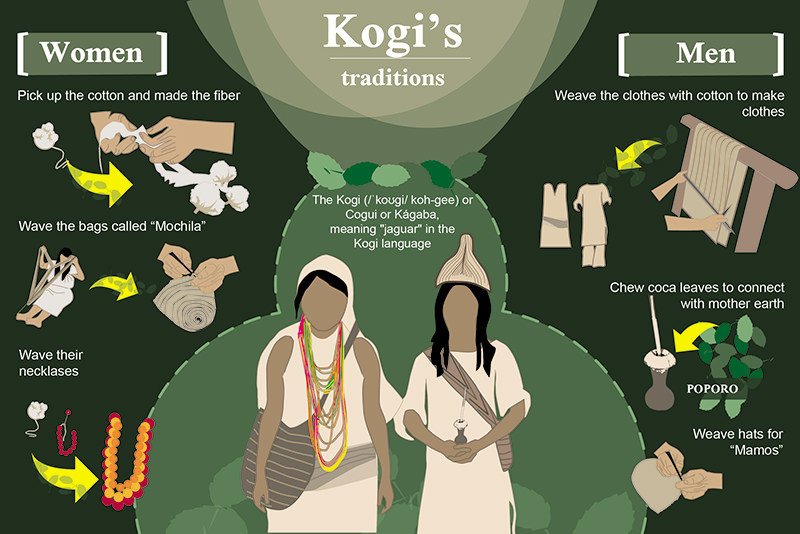
Les femmes portent une tunique blanche avec une épaule dégagée, et portent de jolis colliers de perles multicolores.

The men wear long white pants called Kalasuna, as well as a long-sleeved shirt, always with their mochilas on their chest.

The clothes are made on a Telar (loom) whose shape would represent the 4 ethnic groups by its 4 ends. The crossings of the middle bars represent the snow-covered peaks.
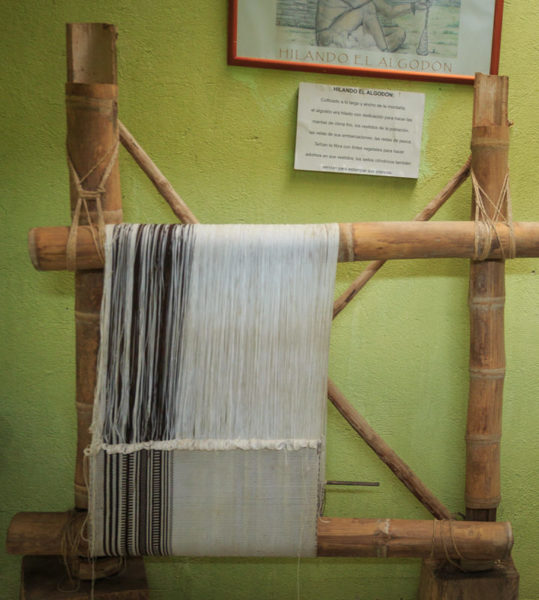
Men make their own clothes. The clothes are made from a variety of cotton endemic to the Sierra Nevada, whose flowers are slightly smaller than the cotton we know. Cotton would have the ability to store thoughts like a USB key It happens that if a man behaves badly or has lost his values, the Mamo will ask him to undo all his clothes and redo them completely, in order to meditate, and re-consign positive thoughts in his new tunic. the necklaces have meanings: according to the colors of the stones. Some colors are for water, coca, etc…
I’m going to weave the canvas of my life I’m going to weave it white like a cloud I’m going to weave something black into it I’m going to weave some dark marks of corn, I’m going to weave corn marks into the white fabric I will obey the divine law Every sound in the mountain is an element of the language of the spirit. Each object a symbol of other possibilities
Kogi thought
The Stones
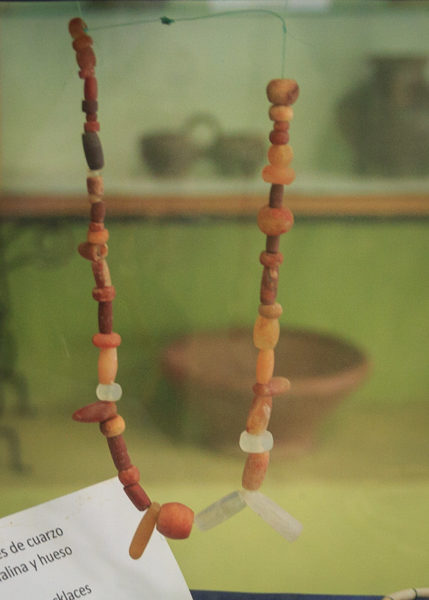
The Gold
The Taironas made statuettes using the lost wax technique, which made it possible to have relics in volume with great finesse in detail. Most of the pieces were made in the centuries preceding the conquest, and some would date back to the 6th century.
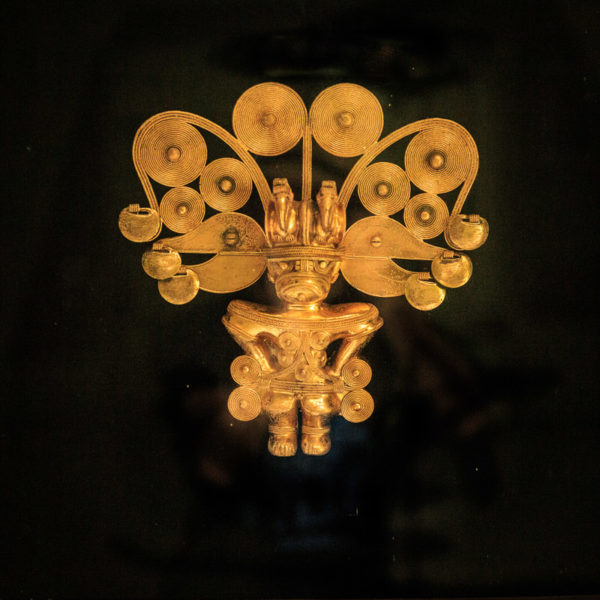
Unfortunately, following the annihilation of the culture by the settlers, these craft techniques have completely disappeared from the current indigenous culture. Their vision of gold was totally different from ours. It was seen as an offering to be improved by man. Gold coins were hung on trees as offerings, worn around the neck as jewelery, or nariguera (jewelery worn on the nose). Gold carried within it the mystery of life from Aluna to matter. For them, this precious metal was not a sign of wealth, and could be exchanged for other raw materials such as the salt produced by the Muiscas.
The Great Archaeological Sites of Taironas
Ignored from the civil world until the years 70, the Lost city or Ciudad Perdida is the most beautiful vestige of the Tairona culture.
A complex of more than 250 terraces in the heart of the Sierra Nevada. At the time, they housed a large shopping centre (but not like ours !).
It was probably the nerve center of the entire Sierra Nevada, and it is estimated that at least 3000 people lived there.
The terraces were then occupied by the Taironas houses.
This is undoubtedly the reason why so much gold is found in these places and why the guaqueros (grave robbers) completely lost their minds when they discovered it. They ended up killing each other (well done for them…).
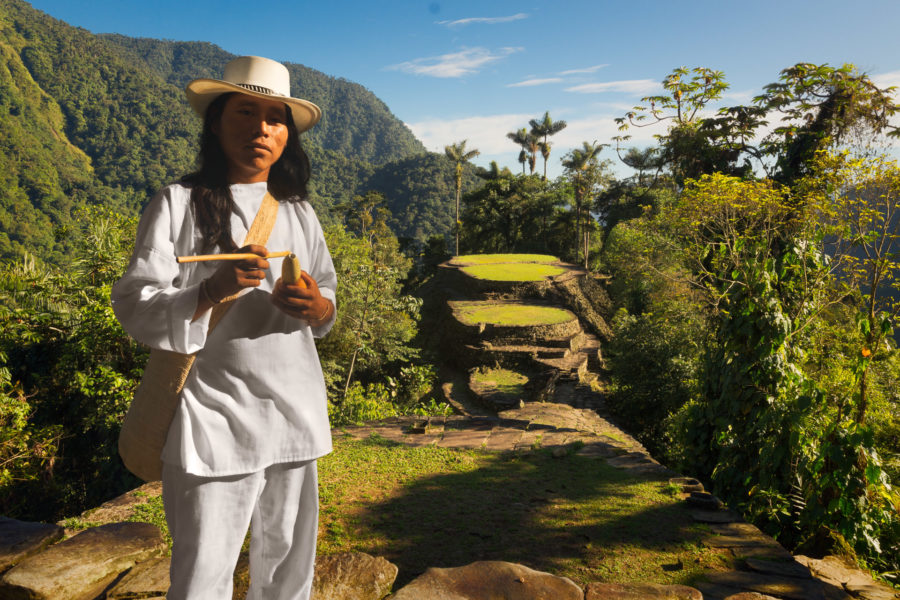
The Kogi Message
If we abuse the earth’s resources too much, an imbalance begins to form and chaos and ecological disasters follow. Since the 1990s, when it became clear that global warming was beginning to affect the world, the Kogis sent a message to the world through archaeologists from the University of Lampester, in a film sponsored by the BBC. The Kogis sent a warning to the “little brothers”. This beautiful 1h30 report by the Irish Alan Ereira has recently been put online. You will discover more about Kogi culture and their message:
How Do The Kogis View Us ?
Little brothers or “hermanitos menores” are all people who are not part of the villages of the Sierra Nevada and who no longer know or practice the law of origin. They consider us as children. For the Kággabba, violence is one of the little brothers who know no limits when it comes to exploiting the planet’s resources, they only seek accumulation, as well as to appropriate all that nature has to offer.
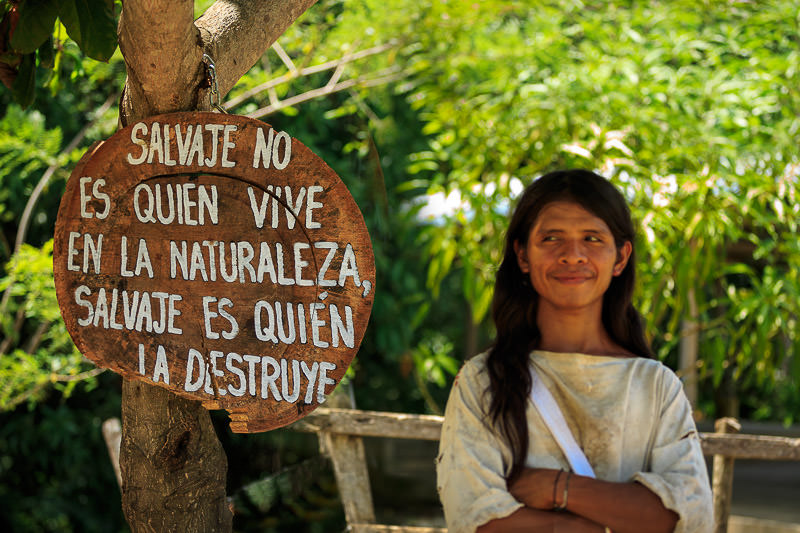
We must not believe that the Kogis will welcome us with open arms into their society, quite the contrary, the less they see us the better they are. They always have a certain mistrust when they meet us, and always keep in mind the atrocities that civilians have inflicted on them. Although they consider us different, they do not trap their society away from us because there is only one world and one mother. One mother for all humans and therefore for older and younger brothers. Some Kogis think we’re going to have to go to the apocalypse, our madness of destruction will not stop. We will therefore have to go through total destruction, so that there is nothing left. To rebuild on a new basis.
The Arhuacos are also fervent defenders of nature. I also invite you to watch this magnificent video “Voice of the Sacred Mountains” made in 2018 on the occasion of the struggles against the mining projects in the Sierra Nevada.
How to help the Kogis ?
1. Protect the nature To help the Kogi it’s very simple: start by helping yourself, in other words help the planet! Their message is clear and that is all they are asking for. We all think we are a little green, aware and we often say that it is others who are destroying the planet. But when we complain that in Brazil they raze the Amazon forest for cattle breeding and palm oil, and then we eat meat every day, we shouldn’t look any further….
If we compare our way of life to that of the Kogis, even turning on the tap for 5 seconds is a destruction. We do not even realize that capturing water is putting nature at risk, so innocent and natural does this daily act of drinking tap water seem to us. In short, we have a long way to go…
Foundations that help the Kogis
Thekendukua : Eric Julien’s famous association has allowed them to return more than 1500 hectares. This is the best way for me to help them because we know that they will let nature take back its rights to these lands. The return of trees, shade, water and wildlife would also provide them with more opportunities to feed. Shibldulda A foundation recently created and managed by the Kogis themselves. TaironaTrust : English foundation created following the film “Aluna” directed by Alan Ereira.
Mobies & Documentaries
And you? What did you think of the show? What are your impressions of the Kogi people? Do you have any further questions ? I would be happy to hear your impressions of this magnificent culture. Feel free to let me know in the comments below.


Do you know a Mamo Allejandro? I met him in the Black Hills of South Dakota in the late summer two years ago. I have to invite him back there; he asked to be invited back three more times, and I need to find him. My name is Ben and I live in Wyoming. I have been involved with Native America in general and specifically with the Nez Perce, Northern Arapaho, and Eastern Shoshone tribes all my life.
Thanks a lot for your comment
Unfortunately I don’t know him personally. I have heard about him. I guess it is a bit hard to contact them. I will ask to some friends and see I can get his contact. Generally Kogi Mamo’s don’t have phone number so, it can be a bit tricky 🙂
I would love to know more about the ancestral teachings the mothers pass on to their children as I was born in Colombia but robbed from my family, adopted and brought here to the U.S…and as I get older I would like to learn more about my indigenous ancestral ways. Thank you!
Hi Helena,
I don’t really know much about this point. The children are learning a lot watching their parents in a daily basis. They quickly learn how to do the basic tasks. Then comes the meetings during the night in the Nunkhue. Sometimes the Mamo all the children and will teach them their thoughts and traditions.
When only mens are invited to these meetings, the mothers take the chidlren and teach them the music and dances during hours, like the humming bird dance, or the dance of the water. It is played with local drums and Maracas, even gaitas (traditional flutes)
Tristan, I am also a Colombian adoptee. I am curious about whether the indigenous people of Colombia all have similar features or if the round nose and almond eyes of the Kogi are unique. When I visited Colombia I was heartbroken to find that I didn’t see a single person who looked like me. That all changed as I have recently come across images of Kogi children. I see so much of myself in them.
Hi Amanda,
Thanks for your comment
Well I think that everybody is unique, and Colombia is a country with a lot of mixity from everywhere.
Nevertheless each native community has its own unique beauty traits. For example, the Kogi and the Wayuus are not at all alike. There are also differences between the Tikunas and the Emberas.
You are lucky and can be proud to have origins of the Sierra Nevada people!
Bonjour, un énorme merci pour cette immersion de 4 jours. Des souvenirs gravés dans notre mémoire à jamais.
Hello again Tristan,
I just left you a message after having seen the pictures of the Kogis: what beautiful lessons of life!
Thank you once again for this file (the most complete I could find!) which allows us to meet this magnificent people, without going to disturb them. I don’t travel, by taste, but also because my husband and I have many animals. Recently retired, I am writing a first novel and I hope to be able to relay the message of the Kogis through this medium.
Thank you a thousand times for the documentation that you give us here.
All the best for your projects.
Jocelyne
I don’t know if I will receive this message. But I am deeply touched by your report. I am very interested in this community, having a special affinity with Colombia. It is quite clear that these people are visionaries and that their advice is most valuable. It is high time that little brothers listen to their big brothers.
Consciences are waking up, but a lot remains to be done, especially when I see the attitude of people towards nature. I have a 15 years old daughter. This generation is fully aware of the ecological problem of our planet. They talk about it openly at school. They have things to teach us. The Kogis and all these indigenous communities have a lot to teach us about our Mother Earth. We should all listen to them before it is too late. With my sincere thanks.
Yves
Wonderful report, I learned a lot about the Kogis by reading this article so complete.
Thank you Tristan for sharing your love for this people, this culture.
We Europeans should be strongly inspired by them.
They have such wisdom and lucidity about the future of our blue planet.
And thank you for having helped ” rendrez vous en terre inconnue “, a cult show for me and many people around me. I loved this show and I shed many tears because the Kogis are so moving. Frederic Lopez allows us to discover unknown peoples, ancient cultures and lives so different from ours. This inspires me a lot in my travels, the respect, the sharing and the curiosity of all that can be offered to us by travelling very simply.
Good continuation Tristan, happy new year 2019, may it be as the Kogis would want it to be.
Hello Josianne, and thank you for your comment!
As explained above, at the beginning I was very skeptical about the filming of the program “Rendez-vous en Terres Inconnues”, having never seen it. They really did an excellent job of making it. The message of the Kogis came across with great force and touched many more people than if it had been a traditional report. They actually live well as it is, and they all try to get the message across.
I also take my hat off to Arnoult, who worked a lot in the shadow of this program. He did the first scouting and organized everything beforehand. Also an Explorer with a capital E. For more travel inspiration I invite you to read his book: “La Mémoire des brumes, traversée clandestine chez les Papous de Nouvelle-Guinée”.
Good continuation to you! And yes! It’s up to us to reduce our consumption rate, that will be our good resolution for 2019
As a journalist, I would just like to congratulate you, your contribution is excellent, both in reading and in images, the love and passion for your work is reflected, thank you for showing us the most beautiful things of our older brothers.
Hi, I found your site very useful because I am doing a final work to pass to baccalaureate.
I’m doing a final paper on the tayronas and the truth is that this site gave me a lot of information.I’m doing a final paper on the tayronas and the truth is that this site gave me a lot of information.
Thank you very much Samuel
I’m glad you found it useful
Hello.
Excellent explanation. Thanks for sharing.
I would like to know if you can tell me what is the Totem of the Kogui and what meaning it has for them, and what is the representative animal of their culture? I have heard some myths and they mention the Jaguar, is it true?
Thank you
Hello Didii,
thanks for the comment
Well, I have never heard of a totem. Well, their temple is nature. In the house of Reunion, there are four pillars that represent the cardinal points, or the 4 ethnic groups, but they are not totems per se.
About the Jaguar, according to some, the name Kogui would mean “Children of the Jaguar”. They do not worship one in particular, all animals have their importance for them. I know they are afraid of condors because of the paramo, they are dangerous.
Very good article, I felt like I was traveling to that culture.
Thank you very much Valeria
cuales son las creencias de los kogui
Hola Mejia
Esta explicado en la seccion creencias de los Kogis. Espero que le sirve
Thank you very much, Tristan, for this generous & sumptuous sharing
Since the program “RV en Terre inconnue”, the Kogis occupy a quite particular place in my heart. What a magnificent civilization, exemplary even!
Frankly, I cannot simply remain there & I am already deepening the subject by reading works of Eric Julien.
In fact, the discovery of such an evolved people puts balm in my heart: thus, it is possible to live on this planet peacefully, without money, beyond any ambient greed & this, by respecting nature! This touches me in the depths of my being! What a wonder! What a wonder!
Namasté.
Françoise Chapelle / France
Hello Françoise, and thank you for your encouraging message!
I must admit that I discovered this culture 4 years ago and I still can’t get over it! They still impress me as much as the first day! I hope indeed that they will be able to continue to live in peace on their piece of land, but especially when in other countries we become a little more active in the protection of the planet.
Wa!